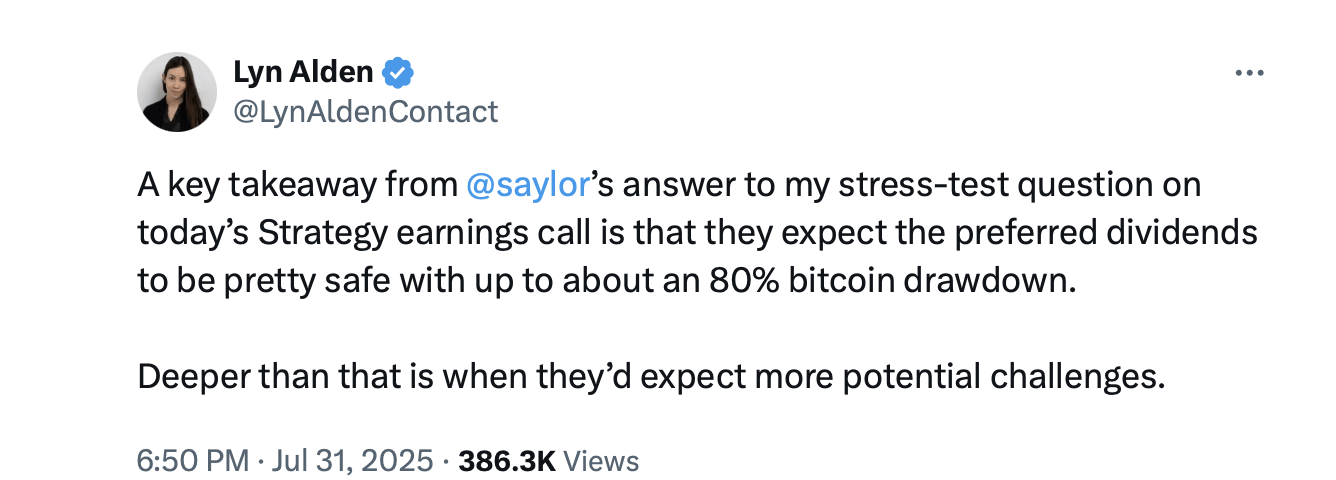The Q&A session during the Strategy earnings call included comments from Executive Chairman Michael Saylor, CEO Fong Li, and CFO Andrew Kang, as they addressed concerns about balance sheet structure, credit instruments, and Strategy’s growing bitcoin holdings—now totaling 628,791 BTC worth approximately $72.18 billion at current exchange rates.

Strategy statistics from strategy.com at 11:40 a.m. Eastern time on Aug. 1, 2025.
TD Bank analyst Lance Vitanza opened by asking whether Strategy’s massive bitcoin holdings could one day hinder the asset’s broader adoption. Fong Li countered that the firm sees itself as a gateway, not a gatekeeper. “Currently, Strategy holds roughly 3% of the bitcoin supply,” Li said.
The Strategy executive added:
“Beyond 5% or 7.5%, price could reach extreme levels, ironically accelerating innovation and participation elsewhere.”
Pressed on whether encouraging other public firms to adopt the bitcoin treasury strategy could backfire, Li argued that the influx of peers is additive. “More companies entering the space helps educate analysts, institutions, and retail investors,” he said. “Each entrant adds capital and legitimacy.”

Renowned financial analyst Lyn Alden raised the issue of drawdown risk, particularly whether Strategy’s asset-backed structure could endure a deep bitcoin crash. Michael Saylor emphasized the advantages of the firm’s preferred equity approach. “Preferred never matures, so even a 90% BTC draw-down wouldn’t impair dividend obligations,” he said.
Saylor continued:
“This model is far more robust and less fragile than conventional banking or bond leverage models.”
Andrew Kang added that the company is battle-tested. “We lived through an ~80% price drop in 2022 with a far weaker capital structure and survived,” he noted. Strategy now leans on custom instruments—STRC, STRK, STRF, and STRD—designed in-house following that cycle.
JAN3 CEO Samson Mow shifted the discussion to yield generation. With bitcoin in a potential consolidation phase, he questioned whether Strategy’s 3× to 9× credit rating products would remain effective. Saylor was optimistic. “Sideways or low-volatility BTC environments aren’t a headwind—they help reinforce our model,” the Strategy boss said.
Clear Street’s Brian Dobson asked what regulatory developments the firm would support. Saylor endorsed classification clarity. “We’d welcome a clear digital asset taxonomy under law,” he said. He specifically mentioned the Clarity Act, expected for review in September, as a legislative step that could benefit the entire crypto sector.
Panelist Jeff Walton closed the session by asking how leverage targets might evolve under Strategy’s preferred-only model. Saylor suggested the firm could gradually raise its target range. “It becomes sensible to extend leverage beyond 20–30%—perhaps into the 30–50% range—because preferred corrects for risk differently,” he said.
Saylor also floated the idea of scaling newer instruments like STRC, which offer floating rates and minimal duration exposure. “Products like STRC effectively decouple interest-rate risk and enable potentially limitless issuance,” he said.
Strategy’s evolving capital structure, coupled with a deepening position in bitcoin, points to a long-term commitment to institutional-grade exposure, regardless of market volatility.
免责声明:本文章仅代表作者个人观点,不代表本平台的立场和观点。本文章仅供信息分享,不构成对任何人的任何投资建议。用户与作者之间的任何争议,与本平台无关。如网页中刊载的文章或图片涉及侵权,请提供相关的权利证明和身份证明发送邮件到support@aicoin.com,本平台相关工作人员将会进行核查。




